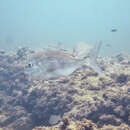Diagnostic Description
provided by FAO species catalogs
Body oval, rather deep and compressed. Head profile regularly convex above, becoming abruptly steeper below eye. Mouth low, slightly oblique. Jaws very strong, lips thick. Anterior teeth canine-like, 4 in upper and 6 in lower jaw, followed by blunter teeth that become progressively molar-like and are arranged in 2 or 3 rows. Behind the row of large canine-like there are some smaller teeth. Gill rakers on first arch 10 to 13 lower and 6 or 7 upper. Dorsal fin with 11 or 12 spines and 9 to 11 soft rays; the first 2 spines always very short, the third to fifth longest, filamentous in the young. Anal fin with 3 spines and 8 or 9 soft rays. First soft ray of pelvic fins filamentous. Preopercle unscaled or with a few scattered, small scales. Scales along lateral line 51 to 54. Colour pink with silvery reflections and large bluish black spots on back and sides. Head darker, particularly on the interorbital space. A dark spot at bases of last dorsal soft rays extending on to the sheath of the fin, but becoming ligther with age. Caudal fin pinkish, the fork edged with black; other fins bluish or pinkish. Old individuals very often with numerous irregular dark spots on head and back; old males with yellow on the head during the reproduction season.
- Akazaki, M. - 1974. In: T. Tomiyama, Fisheries in Japan. Sea bream. Tokyo. 181 p., num. col. Phot.
- Bauchot, M.-L. - 1987. Sparidae In: W. Fischer and M.-L. Bauchot and M. Schneider (eds). Fiches FAO d'Identification des espèces pour les besoins de la pêche (Révison 1). Méditerranée et mer Noire. Zone de pêche 37. Vol. II. Vértebrés: 761-1530.
- Bauchot, M.-L., Hureau, J.-C. & J.C. Miquel - 1981. Sparidae In: W. Fischer, G. Bianchi and W.Scott (eds). FAO species identification sheets for fishery purposes. Eastern Central Atlantic; fishing areas 34, 47 (in part). Canada Funds-in-Trust. Ottawa, Department of Fisheries and Oceans Canada, by arrangement with the Food and Agriculture Organization of the United Nations. Vol. IV : pag. var .
- Bauchot, M.-L. & J.-C. Hureau - 1986. Sparidae In: P.J.P. Whitehead, M.-L. Bauchot, J.-C. Hureau, J. Nielsen and E. Tortonese (eds). Fishes of the North-eastern Atlantic and the Mediterranean (FNAM). Unesco, Paris. Vol. II: 883-907.
- Chabanaud, P. & Th. Monod. - 1927. Les Poissons de Port-étienne, contribution á la faune ichthyologique de la Région du Cap Blanc (Mauritanie Française). Bull. Com. étud. Hist. Scient. Afr. Occid. Fr. 1926, 9: 225-287, 33 fig., 3 pl.
- Günther, A. - 1859. Catalogue of the Acanthopterygian fishes in the collection of the British Museum. 1. Gasterosteidae, Berycidae, Percidae, Aphredoderidae, Pristipomatidae, Mullidae, Sparidae. xxxi + 524 p. London.
- Lloris, D. & J. Rucabado - 1979. Especies ictiológicas de las expediciones pesqueras realizadas en la plataforma del NW de África (1971-1975). Res. Exp. Cient. 8: 3-151. 13 fig .
- Steindachner, F. - 1868. Ichthyologische Notizen. VII. Sber. Akad. Wiss. Wien . 57 (1): 965-1008, 5 pl.
- Tortonese, E. - 1973. Sparidae In: J.-C. Hureau and Th. Monod (eds). Check-list of the fishes of the north-eastern Atlantic and of the Mediterranean (CLOFNAM). Unesco, Paris. Vol. I: 405-415.
- Valenciennes, A. - 1830. Historie naturelle des poissons. In: G. Cuvier and A. Valenciennes. Historie naturelle des poissons. Tome Sixième. Livre sixième. Partie I. Des Sparoïdes . 1-425. in Strasbourg ed.
- Valenciennes, A. - 1843. Ichthyologie des îles Canaries, ou histoire naturelle des poissons rapportés par MM. Webb et Berthelot. In: P.B. Webb et S. Berthelot, Histoire naturelle des Iles Canaries, Paris. 2 (2): 9-96. pl. 20-23.
Distribution
provided by FAO species catalogs
Easthern Atlantic, from Gibraltar to Angola, including the Canary Islands. Also in the Mediterranean and northward to Portugal.
Size
provided by FAO species catalogs
Maximum 95 cm; common to 50 cm.
Brief Summary
provided by FAO species catalogs
Demersal species.Inhabit hard bottoms (rocks and rubble) down to about 150 m depth, the older individuals in the deeper part of this range, the young in inshore areas. Sexual maturity is attained at the age of 2 years. Spawning migrations occur parallel to the coast, with intermittent spawning activity taking place over soft bottoms in shallow water to the north of Cape Verde, throughout the hot season (particulary at its beginning and end).Carnivorous, feeding chiefly on bivalves which it crushes with its powerful jaws. Also crustaceans and fish.
Benefits
provided by FAO species catalogs
A seasonal fishery, particularly during the times of spawning concentrations, mainly in the southern part of its range. Less abundant to the north of Agadir and around the Canary Islands. Caught on line gear, with bottom trawls and seines, and in traps (Canary Islands). Separate statistics are not reported for this species. Flesh esteemed, marketed fresh, frozen or smoked. Also used for fishmeal and oil.
Life Cycle
provided by Fishbase
A different diagnosis of sexual pattern may arise for this species brought about by geographical variations (Ref. 103751). Also Ref. 41163.
Migration
provided by Fishbase
Oceanodromous. Migrating within oceans typically between spawning and different feeding areas, as tunas do. Migrations should be cyclical and predictable and cover more than 100 km.
Trophic Strategy
provided by Fishbase
Inhabit hard bottoms (rocks and rubble), the older individuals in the deeper part of the range, the young in inshore areas. Feed mainly on bivalves and also on crustaceans and fish.
Biology
provided by Fishbase
Generally found in hard bottoms (rocks and rubble), the older individuals in the deeper part of the range, the young in inshore areas. Feed mainly on bivalves and also on crustaceans and fish. Sexual maturity at 2 years old. Spawning migration occurs parallel to the coast with intermittent spawning between spring and autumn over soft bottoms in shallow waters (Ref. 3688).
Importance
provided by Fishbase
fisheries: commercial; gamefish: yes

